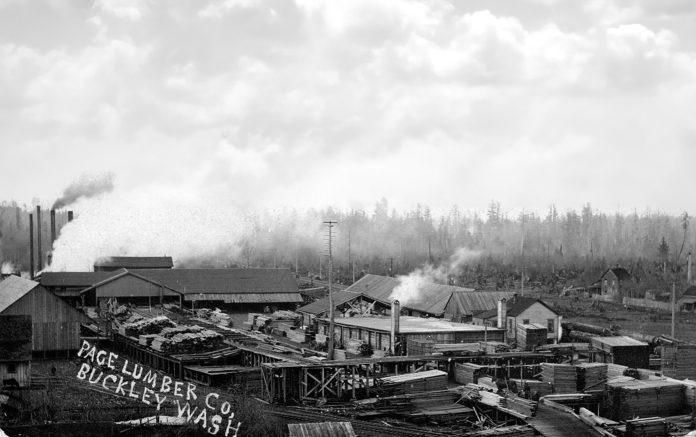It’s said that four resources attracted settlers to the Puget Sound region during the second half of the 19th century – farming, forests, fishing, and mining. Buckley, just across the White River from Enumclaw was founded on farming and forests, though neither undertaking would have been profitable without the Northern Pacific Railroad that arrived in the area on its way to Tacoma between 1886-88.
The message on the back of this post card image of the Page Lumber Company’s saw mill in Buckley, WA. was dated May 22, 1910, and comes courtesy of JoAnne Matsumura, an Issaquah historian and photo collector. Background information was provided by Jean Contreras of the Foothills Historical Museum in Buckley. Photo enhancements were undertaken by Doug ‘Boomer’ Burnham who can be reached at www.BoomersPhotography.com
The saw mill, built in 1895, was originally known as the Buckley Logging and Lumber Mill. By 1900, Page bought the mill which featured the first band-saw in the Northwest as he changed the name to Page Lumber Company. In 1918, Page’s mill was dismantled, and the equipment moved to Eagle Gorge on the Green River where water could power the mill. The Eagle Gorge location is now the site of the Howard Hanson Dam.
While in Buckley the Page saw mill sat next to the railroad on prime real estate located south of Main Street between S.R. 410 and South River Avenue, the former railroad grade. Today, the acreage is home to the library, post office, skate park, Veteran’s Memorial, and other park features.
Paul Page moved to Buckley from Wisconsin in 1896, with his widowed mother, Cynthia Page, and two sisters. In 1901, he married Lillie May Wenter. Page was an early supporter of industrial insurance for workmen’s compensation. By 1921, Paul Page became Assistant Supervisor for the Washington State Dept. of Labor & Industries. He was also known for his civic mindedness, particularly his work for needy families and widows. Later in life, Page studied birds. He died in Tacoma in 1953 at age 93.
Page’s sawmill typically employed between 180 to 240 men, depending on markets and log supplies. Mill laborers usually worked year-round with only occasional shutdowns. The Page mill also provided their employees room and board in bunk houses, designed with private rooms supplied with a bed, mattress, and springs. Laborers provided their own bedding. Room and board costs $5.50 per week with three meals a day. Meat was served at every meal and beans were a staple of calories for the hard-working men. A man called a bull cook cleaned the bunk house, lit the fires, and filled the oil lamps.
Paul Page testified about the timber industry before the U.S. Senate in 1914, providing numerous details about working conditions at his Buckley sawmill. At the Page Lumber sawmill, the minimum wage was $2.50 per day, the maximum was $6.00, and the average mill worker earned $3.62. Laborers in the yard made $2.25 per day.
Up in the logging camps where the timber was fallen and cut to saw log lengths, Page indicated those workers had a minimum wage of $2.25, a maximum of $5.75, with an average of $3.48 per day. He also noted the vast differences between more stable mill workers and those who live in logging camps. Page claimed that loggers were “composed of largely young men, and mostly unmarried men. They are a high-strung class of fellows and reckless – they are in a reckless business, a risky business, and they throw their money away – they are men of that kind.”







